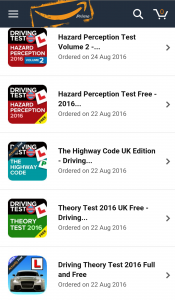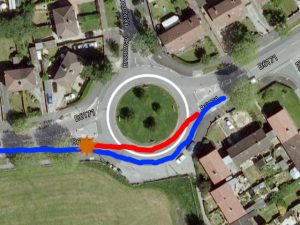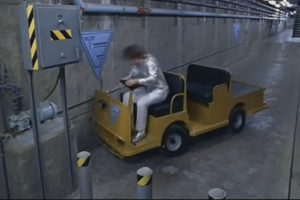A week ago I finally got around to sorting my Theory and Hazard Perception Test, this may shock some since I own cars and number plates with plans to buy more, yet I don’t actually drive. I always joke, why drive when you can be driven ;).

DVLA Trainng Apps
In the middle of August around my birthday, there were an argument or “debate” on Facebook about some minor highway code rule. The original poster said “those who break it shouldn’t have a license”. I checked the highway code before I said anything, and they were wrong. They decided they have been driving since Moses partied with the Hebrews in Gomorrah and they were right, I were wrong. Their reasoning “Because out there in the jungle, I mean on the road its different”. Who shouldn’t have the license really?, perhaps those who think the rules no longer apply to them.
A day or two after that, the 22nd August to be exact, I download the highway code app and various driving apps. I read the highway code, played the different types of quiz and apps. I decided, this is easy, I know this stuff.
On 27th August I booked my Theory and Hazard Perception test for first thing in the morning in just over 2 weeks time. I started to read a dozen different road acts and laws, the official highway code website and anything else that I could find. The day before the test started watching The Strain, I ended up awake until 4am, and had to wake up at 7am to get showered and ready for the test. Powered by Grenade Hydra-6 Chocolate Charge and Gatorade Orange I headed out just before 9am for the test at 10:30am.
The Test Centre
You should arrive around 30 minutes early, this is to allow for queues, check in, and you have some stuff you have to read before hand. As soon as you enter the test centre, even in the waiting area, you must turn your phone off. Not on silent, not aeroplane mode, OFF! failure to do, is a refusal to allow you to do your test.
You queue up, and its important you stand behind the Queue Here stand, otherwise you are told to step back and look a tool which I witnessed several times. Once you have queued up, they ask you for your drivers license, to confirm some details and book you in.
If you have any special requirements, you have to let them know here and they can make provisions. Such as voice overs, larger print, medications, etc.
Lockers
After booking in, they give you a locker key with essentially a brick attached (looks more like an Anne Summers Special) and some information you have to read and agree too. In the locker you have to lock hats, coats, drinks, food, phones, wallets, jackets, fleeces, keys, pens, paper, pretty much anything. This is all on the stuff they give you to read along with other rules and guidelines, 3 pages in total.
The only things you are permitted to take on to the “killing floor” or test booths are suitable clothing, your drivers license and the locker key and brick.
The Test Booths

Theory Test Booths
The room at my test centre were a small is room, with squared semi-circle like a [ shape, with 8 or 9 wooden office dividers, making small booths. There were an observation area behind where the inspector guy sits where he can see all the booths. He explains if there are any problems, raise your hand he’ll come over to you.
Inside each booth were a computer case, a mouse, a keyboard and a white square the size of a mouse mat which says “place your belongings here”. This is where the locker key with the huge stick attached to it, and your drivers license are to be placed. Over head is a CCTV Camera on each booth to watch you’re not cheating and such, and to the left a pair of headphones hung on the divider.
Adjust the seat, and the screen make sure you have a good view, as moving it during the test makes them suspicious. I also suggest adjusting the headphones to fit as you’ll need them later on. You have been logged in by the inspector guy who is behind you, so you just need to click start.
The Actual Test
The test is broken up into various parts, each part has a set time limit, and various controls and options. You are given some choices as well, some you don’t have to do, some you do have to do.
Learning Mode
Initially you are given a system run through over how the system works. Where it asks you to select, and deselect things, change options and such like. I guess this is mostly to test everything works and make sure you can use it.
This is timed at 5:00 minutes.
Practice Mode
You are then given the option of doing a “practice session” which is really just a more in-depth version of the above. In this you are asked to select options, flag options for later review if you are unsure. Explained exactly how it all works, what each option on the menus do, etc.
This works exactly like the real test only it only has about a dozen pages / questions. Its well worth doing this, so you know how to flag and review, I used this feature myself.
This is timed at 15:00 minutes.
Break Time
You are given a short period of time to prepare and relax before you perform the on screen instructions to start the test. You cannot move from your booth at this time and should remain looking forward.
This is timed at 2:00 minutes.
Multiple Choice Theory Test
This is 50 questions, and 43 questions are required to be correct in order to pass. Approx 44 of my questions were general highway code questions. Stopping distances, road signs, vehicle marks, first aid, traffic lights etc, mostly basics.
Towards the end were a “case study”, it gives you approx 6-7 sentences about a fictional journey, for example it may say…
“You are moving house, so you get a roof rack fitted to your car and load it up with your belongings.
You travel down a 3 lane motorway for most of the journey. On this journey you notice a sign with “40” on it over the hard shoulder.
The motorway is quite congested so you move from the left lane to the right lane to overtake slow moving vehicles before moving back to the left lane.
You notice a warning sign saying “Fog Ahead”, shortly after you find yourself in the fog, but it clears up in a few miles.
Some of your belongings fall off the roof rack in the left hand lane. After dealing with this incident, you leave the motorway.
You want to go ahead and take the 3nd exit of 5 on the round about.”

Theory Test Results Screen
It then asked a series of multiple choice questions based on the above description, one of them were like, “while you were overtaking, what colour were the reflective studs on your right”, “What did you do when you saw the fog sign”, stuff like that.
One question answer troubled me, which is related to the left hand lane. Its not clear if round about is on the slip road, nor how many lanes the round about has. It then asks you “which lane would you go in”, with the answers “left, right, middle or most appropriate“, there are other questions like this which are in my opinion are tricky.
This kind of threw me off guard as I hadn’t seen this before in any of the apps or literature I read.
At the end you are told how many incomplete, flagged and answers questions there are on the review screen. You have the option to review the unanswered, the flagged, the answered or indeed the entire test before you hit end test and confirm it.
This is timed at 57:00 minutes.
Break Time Part Deux
You are given anther short break after the Multiple Choice Test, to relax a little bit and prepare for the theory test. You cannot move from your booth during this break.
This is timed at 3:00 mintues.
Hazard Perception Test
Much like the multiple choice section, this is broken into 2 parts. A demo or introduction mode, which talks you through it and shows you step by step how it works.
Followed by the actual test being administered.
Introduction Mode
At the start of the test you are advised to put your headphones on, to listen to the introduction. The introduction shows you a demo video and explains how the clicking works. It explains you should click on developing hazards as soon as you see them develop, and as they are happening. It explains about clicking too fast or too many times, or in any sort of pattern, and you’ll score 0 for that clip.
What I din’t know is, you don’t have to click the mouse where the hazard as is happening, just as soon as you see it developing. You can’t actually see the mouse cursor on the screen unlike in the multiple choice where you can.
After this, it shows the same video click again, and explains the various potential hazards, and shows you how the scoring of 5-1 points would work on that clip when the actual hazard develops and explains the whole clip.
It also tells you, if you click the hazard on 5, then again on 3 and again too late, the computer counts your first click, so you will still score a full 5 for that hazard.
You can watch this twice if you are unsure or the volume were low etc. You don’t need the headphones after this.
This is timed at 5:00 minutes.
The Actual Test
The test is 14 Computer Generated Videos, each lasting 60 seconds (ish) with a 10 second break between each one. Do NOT click the mouse during the 10 second countdown as it can register those clicks and result in a 0 score penalty.
One of the videos has 2 hazards, the other 13 have only 1 hazard.
Each hazard you spot, depending on how early you catch it developing is worth up to 5 points. You need a minimum of 44 points to pass, this is out of a possible 75 points.
What I did is click each potential hazard as soon as I saw it, then clicked again if and when it developed. This didn’t trigger any penalties, and seemed acceptable.
This is timed at 15:00 minutes.
Potential Questions
At the end it may or may not ask you about some potential future questions, you were asked before the test started if you were interested in these. These don’t affect your test score at all. These are questions which they are considering adding to the multiple choice or hazard tests in future.
For me this were about 5 multiple choice questions, which seemed to be more like “word play” on existing questions. For example in the theory test, I were asked:
What is the stopping distance when travelling at 50mph ?
in the potential future questions I were asked:
What is the stopping distance on a clear, dry road while travelling at 50mph?
This may mean there is also a “What is the stopping distance on a wet road at 50mph?” question in the bank, somewhere or maybe its just wordplay to make you question it.
Customer Satisfaction
Lastly you are asked about a dozen questions, everything from how long did it take to get your provisional license, if you booked online how happy are you with the service, were you happy with the way the system worked etc.
One question threw me a little “What is your ethnicity, this is so we can ensure the test is administered fairly”, how exactly is knowing if I’m black, white or polkadot going to change how the test is administered ?
My Test Results
I scored 49 correct multiple choice out of 50 (98%), and 67 hazard points out of 75 (90%), giving me 94% total score. So I got a pretty good pass, a very good pass for some ones first test, and apparently astonishing for someone who has never had a professional driving lesson in their life.
A Manchester Based Photographer and Website Developer with interests in Strongman, Fitness and Geekery.








